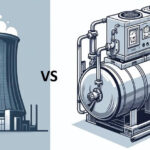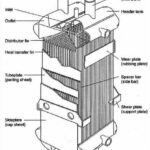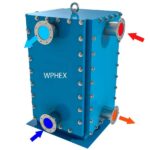What is a distillation column? A distillation column is a vertical vessel used in the distillation of liquid mixtures to separate the mixture into its individual components based on their boiling points. The mixture is heated to produce vapours, which are then cooled and condensed back into a liquid form. The liquid components are collected in trays or plates placed at different heights within the column, based on the boiling point of each component. This allows for the separation of the mixture into its individual components, which can then be withdrawn from the column for further processing or use.
Distillation columns are commonly used in the petrochemical, chemical, and pharmaceutical industries to purify and separate various chemicals, as well as in the production of alcoholic beverages. The design and operation of a distillation column can vary greatly depending on the type of mixture being distilled and the desired product specifications.
What are the types of distillation columns
As we have answered what is a distillation column there are several types of distillation columns, each with a unique design and purpose:
- Batch distillation columns: These columns are used to separate a mixture in a single batch. They are commonly used for small-scale applications, such as the production of alcoholic beverages.
- Continuous distillation columns: These columns are used to separate a mixture continuously, with the mixture being continuously fed into the column and the separated components being continuously withdrawn. They are commonly used in the petrochemical industry for the separation of crude oil into its various components.
- Packed distillation columns: In this type of column, a packing material, such as ceramic or metal rings, is placed within the column to increase the surface area for vapor-liquid contact. This allows for more efficient mass transfer and improved separation.
- Trayed distillation columns: In this type of column, trays or plates are placed at various heights within the column to allow for the separation of the mixture. The liquid components are collected on the trays, and the vapors are drawn off and condensed.
- Short-path distillation columns: These columns use a shorter distillation path and are commonly used for the separation of high-boiling and high-molecular weight components, such as waxes, oils, and resins.
- Fractionating columns: These are specialized columns used in the fractional distillation of mixtures. They are commonly used in the chemical and pharmaceutical industries for the separation of complex mixtures into their individual components.
The type of distillation column used for a specific application will depend on the type of mixture being distilled, the desired product specifications, and the scale of the operation.
Advantages and disadvantages of a distillation columns
After discussing what is a distillation column and their types, below are some advantages and disadvantages.
| Advantages | Disadvantages |
|---|---|
| High efficiency: Distillation columns are highly efficient at separating mixtures into their individual components, making them ideal for purifying and separating complex mixtures. | High energy consumption: Distillation columns require significant energy to heat the mixture and to cool and condense the vapours, making it an energy-intensive process. |
| Versatility: Distillation columns can be designed and operated to separate a wide variety of mixtures, including liquids, gases, and multi-component mixtures | Complexity: The design and operation of distillation columns can be complex, requiring specialized knowledge and expertise. |
| High purity: The distillation process results in highly purified individual components, making it ideal for applications in the chemical and pharmaceutical industries. | Cost: The cost of purchasing and operating a distillation column can be high, particularly for large-scale operations. |
| Scalability: Distillation columns can be designed for small-scale or large-scale operations, making them suitable for a wide range of applications. | Limited separation capabilities: Distillation columns are not always suitable for separating mixtures that have similar boiling points or for separating mixtures that contain very volatile components. |
| Safe: When designed and operated properly, distillation columns are a safe method for separating mixtures. | Environmental impact: The energy consumption and potential release of emissions associated with distillation columns can have a negative impact on the environment |
I hope this short article give you some useful information about what is a distillation column.
Keywords: what is a distillation column, distillation column












